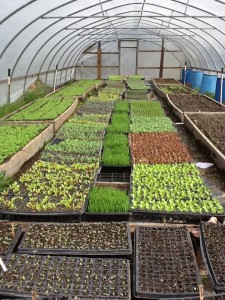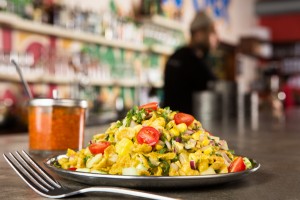Acclaimed Atlanta chefs revel in the bounty of farmers markets offering fresh produce to craft the seasonal dishes.
By Bret Love
Over the past couple of decades, popular food-focused television shows have elevated chefs to rock star status. From Anthony Bourdain to Gordon Ramsay and Nigella Lawson, shows such as “Top Chef” and “The Taste” have made celebrities of these kitchen craftsmen.
At the same time, there has been a gradual shift in the culinary world away from the flashier experimental tendencies of the molecular gastronomy movement and toward the simplicity of the “slow food” approach. Built around traditional regional cuisines, with a focus on sustainable agriculture and fresh ingredients, the slow food movement places as much of a spotlight on the farmers who grow those locally sourced ingredients as it does on the chefs themselves.

Steven Satterfield, executive chef and co-owner of Atlanta’s critically acclaimed Miller Union restaurant—a 2014 James Beard Award semifinalist (and 2013 finalist) for Best Chef Southeast and a proponent of the slow food movement—suggests that buying ingredients locally has myriad benefits for both the consumer and their community.
“First off, the food did not have to travel miles and miles to get to us,” he explains. “This means that it’s fresher, tastes better and has more living nutrients. You can taste the difference. Secondly, when we support growers in our region, we boost the local economy. We also raise awareness of our region’s bounty, and celebrate ingredients with our food heritage. The consumer and the producer both benefit from this connection. There is a farm-to-table movement for a reason. It really means something.”
A Growing Movement
Italian journalist and activist Carlo Petrini launched the slow food movement in 1986 during a time when there was much public opposition against plans to open a McDonald’s restaurant near the Spanish Steps in Rome. Promoted as an alternative to modern society’s increasing reliance on fast food, the farm-to-table philosophy was rooted in a desire to preserve the historic connection between agriculture and gastronomy. The movement has since attracted a growing legion of devotees, with more than 150,000 members in over 150 countries.
Of course, while hip buzzwords such as “sustainability” and “locavores” are still relatively new, using locally sourced ingredients in food was once the only choice available to chefs. And, as illustrated by Meherwan Irani, executive chef of Chai Pani in Decatur, Ga., it remains the sole option in many parts of the world.
“For me, this isn’t a fad: It’s the only way I know how to cook,” says Irani, a James Beard Award semifinalist for Best Chef Southeast. “Except in the big cities, most of India doesn’t have supermarkets like we do in the West. Every day, I’d have to go to the market and buy whatever the regional farmers were able to carry to the market. So cooking based on seasonal ingredients was—and, for the most part, still is—the norm. The only way I know to make sure we don’t screw up the home-cooked authenticity of what I grew up with, is to stick to buying fresh ingredients.”

Joseph Trevino, executive chef at The St. Regis Atlanta, says he always seeks the freshest products available from local growers for both the flavor and environmental aspect. “Fresh product has greater shelf life, so we can do more things with it,” he explains. “From a sustainability factor, we want to make sure that our carbon footprint decreases year after year. The more that we can buy locally and encourage local farmers to supply us with the freshest products, the more impact we will make overall in terms of lowering our environmental impact.”
Farm Fresh
Fortunately, as more chefs and food aficionados have adopted the slow food approach to cuisine, more farmers around Georgia have been stepping up to provide fresh, sustainably grown seasonal ingredients for chefs to choose from for their dishes. From the produce of Winterville’s Woodland Gardens and Calhoun’s Rise ’N Shine Organic Farm to the meats of Bluffton’s White Oak Pastures and the cheese of Elberton’s Nature’s Harmony Farm, these independent growers’ names are cropping up on the menus of some of Atlanta’s finest chefs.
Trevino is a strong supporter of Loganville’s Dillwood Farms, particularly its long-stemmed arugula, which he says comes closer than most to the rocket grown in Western Europe. “The arugula you get at the supermarket is really dull, without a lot of pepper—like an extremely bland lettuce,” Trevino says. “But Dillwood’s arugula is hearty, spicy and pungent, just like it should be. It pops on your palate. That’s something we get really excited about when summer arrives.”

Dillwood Farms’ seasonal produce can be found at the Snellville and Tucker farmers markets, one of many in the area frequented by the city’s top chefs. Markets range from the multicultural hodge-podge of the Buford Highway Farmers Market and the bountiful produce of the Dekalb Farmers Market to the friendly neighborhood vibe of the Decatur, Morningside and East Atlanta Village markets.
Shopping at farmers markets provides a clear benefit, according to Billy Allin, executive chef and co-owner of Cakes & Ale restaurant in Decatur—and semifinalist for the James Beard Award for Best Chef Southeast. “As vegetables sit, they die more and more,” Allin says. “During that process, they’re going to lose flavor, texture, vitamins and minerals. So the fresher something is, the better it tastes. When you buy from a farm or a farmers market, they’re going to bring the stuff that they feed their families.
“There are all these farmers working really hard to produce food items that they have a passion about, and that are better for us,” Allin continues. “We could make more money buying from larger purveyors, but we think it’s important to support microeconomies in a growing world of macroeconomy. It may be the worst business plan in terms of running a restaurant, but it makes us feel good.”
In fact, Allin has gone beyond shopping at farmers markets to co-founding one—the Freedom Farmers Market, which takes place every Saturday at The Carter Center.
“It is an awesome market,” Allin says with obvious pride. “If you haven’t been, then definitely go. It’s not like a grocery shopping event, where you go, get what you need, and leave. It’s a communal place, where you walk around and you see friends. The core tenant is Woodland Gardens … based outside of Athens.
“Celia Barss’ leafy greens are always amazing, whether it be kale, chard or lettuces. In the early summer, I love their peppers and eggplant,” Allin continues. “She not only brings beautiful vegetables that you just want to photograph, but she’s treating the soil properly and you’re getting great flavor out of it.”
This notion of treating the soil properly, growing fruits and vegetables sustainably, and then preparing dishes in a simple way that highlights the natural flavors of the ingredients seems to be the core ideal of the slow food movement. The farm-to-table ethos can be boiled down to treating both the planet and its inhabitants better by becoming more conscious about how food is grown and making careful choices when selecting what to eat.
Savoring Summer
With such a bounty of summer produce available at farmers markets, Atlanta’s top chefs have plenty of delicious dishes they love to prepare—both at their restaurants and at home—to showcase the fresh, seasonal ingredients.
Trevino allows the produce to shine in his beet-cured salmon with arugula, watermelon radish, yogurt cheese mousse and kumquat emulsion, while Irani loves making corn bhel.

“It’s fresh sweet summer corn, roasted on the grill in husks and then shaved,” Irani says of the bhel. “… [You mix it with] fresh crisp cucumbers, local cherry and grape tomatoes, fragrant cilantro, red onions and a dressing of fresh squeezed lime juice, roasted cumin seed powder, shallots, black pepper, young garlic and virgin olive oil. Then I toss it with freshly made puri crisps. It tastes like summer.”
For Allin, “agrodolce” is a go-to summer recipe that can be added to several dishes. “The sweet-and-sour effect created by reducing vinegar and sugar is very Italian,” he says. “We do eggplant agrodolce … or it can be a base for a salad. It can do anything. Every season, I think about one ingredient I’m excited for, and eggplant is a given every summer, because it’s a chameleon of a vegetable.”
Another summer staple, the versatile tomato, stars in Satterfield’s dish of choice this season. “I make heirloom tomato panzanella, a classic Italian peasant dish that came about many years ago as a way to use up stale sourdough bread and over-ripe tomatoes,” he shares. “A million variations have sprung up since, typically including some olive oil and vinegar. My variation includes other tidbits from the garden, such as onion, cucumber, garlic, bell pepper, celery and basil.”
Whether crops come from a home garden or farmers market, in the end, the slow food approach is all about growers, chefs and diners making better choices. It’s about a return to the way food historically was produced, prepared and consumed in the centuries before the Industrial Revolution made mass production and international distribution possible. It’s about the simple pleasures of a great meal prepared using quality ingredients grown within 100 miles of the table upon which it is served.
And there’s no better time to embrace this approach than summer, when the fields are full of produce at the peak of perfection.








